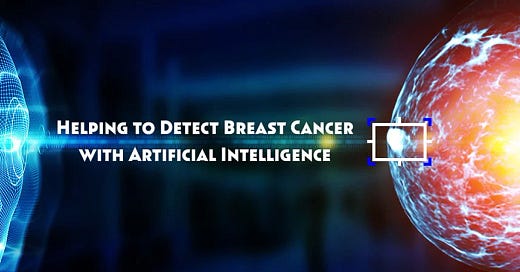The news often amplifies stories that highlight the worries and challenges surrounding Artificial Intelligence (AI), focusing on its potential risks rater than its benefits. But, AI increasingly being integrated into healthcare applications, offering innovative solutions that enhance chronic disease screening, improve detection accuracy, and alleviate administrative burdens for healthcare providers. AI techniques, including deep learning, are proving valuable in breast cancer screening. These technologies are not only aiding in more accurate diagnoses but also improving efficiency, which is crucial in a high-demand, resource-limited environment.
Several studies have demonstrated the potential of AI in breast cancer. For instance, research by Shen et al. showed that AI application in breast cancer screening led to a significant reduction in false-positive rates by 37.3% and a reduction in biopsy requests by 27.8% while maintaining sensitivity.2 Importantly, their findings also indicated that AI systems outperformed human experts in interpreting breast ultrasound images. This points to AI's capacity to augment diagnostic accuracy and streamline clinical workflows, potentially reducing unnecessary interventions and enhancing patient care.
Several studies have found that AI use for breast cancer screening is most efficient when applied in conjunction with human expertise. In some cases, AI has been shown to improve the consistency and accuracy of diagnoses when used to assist human readers, either by replacing a single reader or functioning as part of a decision support system.3,4,5 AI can also be used to identify potential false-negative interval cancers thereby facilitating earlier detection and treatment.6
Beyond early detection, AI has the potential to revolutionize breast cancer care by helping to predict treatment responses, optimize personalized treatment strategies, and improve patient outcomes.7 AI could be instrumental in assessing how tumors respond to chemotherapy, identifying the most effective treatments, and predicting the risk of recurrence through post-treatment MRI analysis.8,9 By analyzing patterns in large datasets, AI can offer predictive insights that may not be readily apparent to human clinicians.
While AI holds tremendous promise, its use in breast cancer diagnosis and treatment must be responsible, transparent, and ethical. Ensuring responsible AI involves several critical considerations that go beyond simply implementing the technology including extensive clinical validation, ensuring model generalizability, navigating the “black box” conundrum and pragmatic considerations of embedding AI into everyday clinical environments.10 Most AI algorithms are often considered black boxes because it is often unclear which features are used in decision-making. Responsible AI requires developing explainable AI algorithms to build trust among clinicians, providing transparency in the decision-making process, and alleviating biases.11
Mindi Messmer, MS, PG, CG is an environmental and public health scientist and author of Female Disruptors: Stories of Mighty Female Scientists. The book is available on Amazon, Barnes & Noble and through your local bookstore.
References
1-Helping to Detect Breast Cancer with Artificial Intelligence. Medical Professionals. https://www.medical-professionals.com/en/detecting-breast-cancer-with-artificial-intelligence/. Published June 19, 2024.
2- Shen Y, Shamout FE, Oliver JR, Witowski J, Kannan K, Park J, et al. Artificial intelligence system reduces false-positive findings in the interpretation of breast ultrasound exams. Nat Commun. 2021;12:5645. doi: 10.1038/s41467-021-26023-2.
3- Salim M, Wåhlin E, Dembrower K, et al. External evaluation of 3 commercial artificial intelligence algorithms for independent assessment of screening mammograms. JAMA Oncol. 2020;6(10):1581–8. doi: 10.1001/jamaoncol.2020.3321.
4-McKinney SM, Sieniek M, Godbole V, et al. International evaluation of an AI system for breast cancer screening. Nature. 2020;577(7788):89–94. doi: 10.1038/s41586-019-1799-6.
5- Leibig C, Brehmer M, Bunk S, Byng D, Pinker K, Umutlu L. Combining the strengths of radiologists and AI for breast cancer screening: a retrospective analysis. Lancet Digital Health. 2022;4(7):e507–19. doi: 10.1016/S2589-7500(22)00070-X.
6- Lång K, Hofvind S, Rodríguez-Ruiz A, Andersson I. Can artificial intelligence reduce the interval cancer rate in mammography screening? Eur Radiol. 2021;31(8):5940–7. doi: 10.1007/s00330-021-07686-3.
7-Ahn JS, Shin S, Yang SA, Park EK, Kim KH, Cho SI, Ock CY, Kim S. Artificial Intelligence in Breast Cancer Diagnosis and Personalized Medicine. J Breast Cancer. 2023 Oct;26(5):405-435. doi: 10.4048/jbc.2023.26.e45. PMID: 37926067; PMCID: PMC10625863.
8- Huynh BQ, Antropova N, Giger ML. Comparison of breast DCE-MRI contrast time points for predicting response to neoadjuvant chemotherapy using deep convolutional neural network features with transfer learning; Proceedings of the SPIE; 2017 Feb 11-16; Orlando, FL. Bellingham, WA: SPIE; 2017. [Google Scholar]
9- Qu YH, Zhu HT, Cao K, Li XT, Ye M, Sun YS. Prediction of pathological complete response to neoadjuvant chemotherapy in breast cancer using a deep learning (DL) method. Thorac Cancer. 2020;11:651–658. doi: 10.1111/1759-7714.13309.
10- Ha R, Chang P, Mutasa S, Karcich J, Goodman S, Blum E, et al. Convolutional neural network using a breast MRI tumor dataset can predict oncotype Dx recurrence score. J Magn Reson Imaging. 2019;49:518–524. doi: 10.1002/jmri.26244.
11- Gastounioti A, Kontos D. Is it time to get rid of black boxes and cultivate trust in AI? Radiol Artif Intell. 2020;2:e200088. doi: 10.1148/ryai.2020200088.




